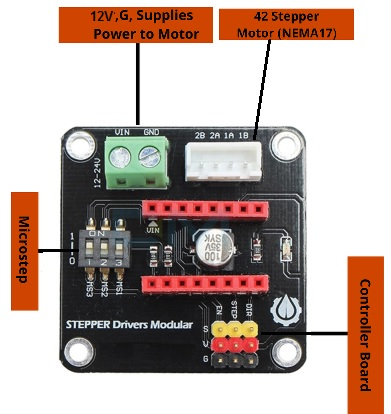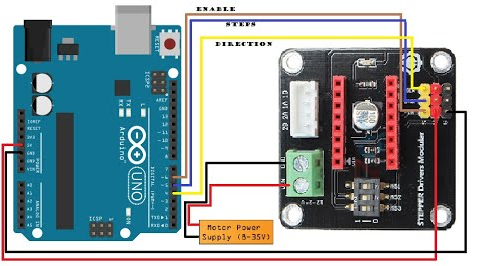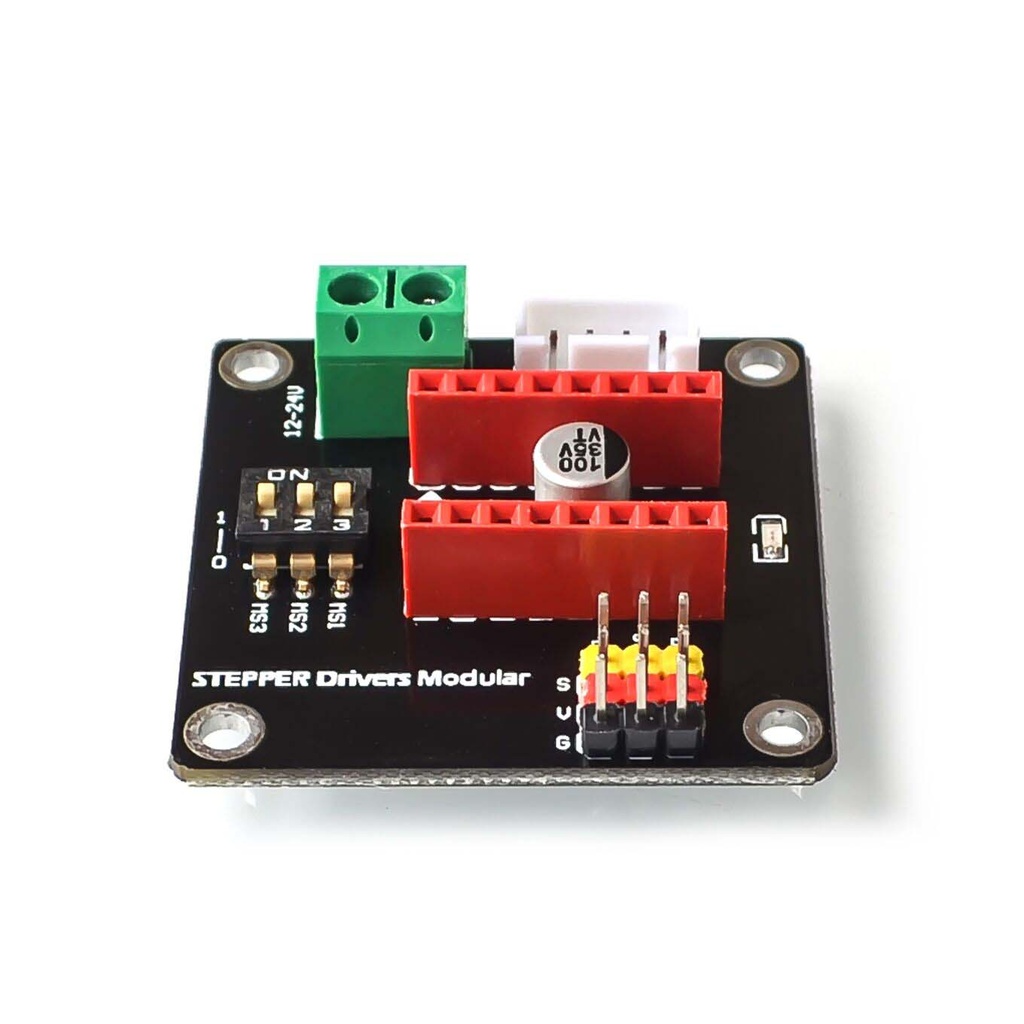Features:
- On-board DIP switch for easy adjustment of drive segments
- Digital ports compatible with A4988 and DRV8825 drivers
- Terminal power connectors for easy connection of drive power
- Compatible with 12/24V drive scheme
- The logic voltage of 5V and input voltage ranging from 12-30V
- Suitable for 42 stepper motor drives, 3D printers, and DIY projects
- Interfaces for rotation enable, direction, and speed control are all led out
- Compatible with the Arduino 3P interface
- Compact size of 42 x 42 x 15mm
- Uses A4988 and DRV8825 chips on the board
Principle of Work:
The board interfaces a microcontroller with a stepper motor, using a DIP switch to control step modes. The input signals manage direction, enable, and step control. It supports external motor power while sharing GND with the microcontroller.
Pinout of the Module:

- VIN: Motor power input (12–24V)
- GND: Ground reference
- VDD: Logic power input (3V–5V)
- DIR: Direction control (HIGH/LOW)
- STP: Step control input (pulse-based)
- MS1, MS2, MS3: Microstepping mode selection
- EN: Enable signal
- MA, MB: Stepper motor coil outputs
Applications:
- Robotics: For precise control of robotic arms or mechanisms
- CNC Machines: Controls motors in 3D printers, laser cutters, mills
- Automation: Used for conveyor systems and robotic automation
- Camera Sliders: Time-lapse and video slider control
- Telescope Mounts: Accurate celestial tracking
Circuit:
The stepper motor driver board connects to Arduino using pin 6 (enable), pin 5 (step), and pin 4 (direction). Power must be supplied externally, while GND is shared with Arduino.

Library:
No library needed
Code:
int Index;
void setup()
{
pinMode(6, OUTPUT); // Enable
pinMode(5, OUTPUT); // Step
pinMode(4, OUTPUT); // Direction
digitalWrite(6, LOW);
}
void loop()
{
digitalWrite(4, HIGH);
for (Index = 0; Index < 2000; Index++)
{
digitalWrite(5, HIGH);
delayMicroseconds(500);
digitalWrite(5, LOW);
delayMicroseconds(500);
}
delay(1000);
digitalWrite(4, LOW);
for (Index = 0; Index < 2000; Index++)
{
digitalWrite(5, HIGH);
delayMicroseconds(500);
digitalWrite(5, LOW);
delayMicroseconds(500);
}
delay(1000);
}
Explanation:
The loop alternates stepper motor direction by setting the DIR pin HIGH or LOW, then sends 2000 step pulses with delays for rotation. After a short pause, the direction changes and repeats.
Technical Details:
- Size: 42 x 42 x 15mm
- Mounting Hole: 3mm
- Pitch: 1400 x 1400mil (35.56 x 35.56mm)
- Logic Voltage: 5V
- Input Voltage: 12–24V
- Ports: Digital
- Interface: Direction, Enable, Speed
- Compatible Drivers: A4988, DRV8825
Comparisons:
Without this expansion board, users must directly connect DRV8825/A4988 modules to the microcontroller and manage all wiring manually. With the expansion board, stepper control is easier, faster, and more beginner-friendly with onboard circuitry and pin breakout for direct plug-and-play use.
Features:
- On-board DIP switch for easy adjustment of drive segments
- Digital ports compatible with A4988 and DRV8825 drivers
- Terminal power connectors for easy connection of drive power
- Compatible with 12/24V drive scheme
- The logic voltage of 5V and input voltage ranging from 12-30V
- Suitable for 42 stepper motor drives, 3D printers, and DIY projects
- Interfaces for rotation enable, direction, and speed control are all led out
- Compatible with the Arduino 3P interface
- Compact size of 42 x 42 x 15mm
- Uses A4988 and DRV8825 chips on the board
Principle of Work:
The board interfaces a microcontroller with a stepper motor, using a DIP switch to control step modes. The input signals manage direction, enable, and step control. It supports external motor power while sharing GND with the microcontroller.
Pinout of the Module:

- VIN: Motor power input (12–24V)
- GND: Ground reference
- VDD: Logic power input (3V–5V)
- DIR: Direction control (HIGH/LOW)
- STP: Step control input (pulse-based)
- MS1, MS2, MS3: Microstepping mode selection
- EN: Enable signal
- MA, MB: Stepper motor coil outputs
Applications:
- Robotics: For precise control of robotic arms or mechanisms
- CNC Machines: Controls motors in 3D printers, laser cutters, mills
- Automation: Used for conveyor systems and robotic automation
- Camera Sliders: Time-lapse and video slider control
- Telescope Mounts: Accurate celestial tracking
Circuit:
The stepper motor driver board connects to Arduino using pin 6 (enable), pin 5 (step), and pin 4 (direction). Power must be supplied externally, while GND is shared with Arduino.

Library:
No library needed
Code:
int Index;
void setup()
{
pinMode(6, OUTPUT); // Enable
pinMode(5, OUTPUT); // Step
pinMode(4, OUTPUT); // Direction
digitalWrite(6, LOW);
}
void loop()
{
digitalWrite(4, HIGH);
for (Index = 0; Index < 2000; Index++)
{
digitalWrite(5, HIGH);
delayMicroseconds(500);
digitalWrite(5, LOW);
delayMicroseconds(500);
}
delay(1000);
digitalWrite(4, LOW);
for (Index = 0; Index < 2000; Index++)
{
digitalWrite(5, HIGH);
delayMicroseconds(500);
digitalWrite(5, LOW);
delayMicroseconds(500);
}
delay(1000);
}
Explanation:
The loop alternates stepper motor direction by setting the DIR pin HIGH or LOW, then sends 2000 step pulses with delays for rotation. After a short pause, the direction changes and repeats.
Technical Details:
- Size: 42 x 42 x 15mm
- Mounting Hole: 3mm
- Pitch: 1400 x 1400mil (35.56 x 35.56mm)
- Logic Voltage: 5V
- Input Voltage: 12–24V
- Ports: Digital
- Interface: Direction, Enable, Speed
- Compatible Drivers: A4988, DRV8825
Comparisons:
Without this expansion board, users must directly connect DRV8825/A4988 modules to the microcontroller and manage all wiring manually. With the expansion board, stepper control is easier, faster, and more beginner-friendly with onboard circuitry and pin breakout for direct plug-and-play use.


